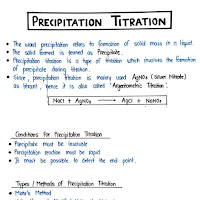Unit-2 Pharmaceutical Analysis Handwritten Notes: Precipitation, Complexometric, Gravimetry, and Diazotization Titrations
Download these handwritten notes covering Unit-2 of Pharmaceutical Analysis, focusing on Precipitation titrations, Complexometric titrations, Gravimetry, and Diazotization titrations. These notes provide a simplified overview of the principles, methods, and applications of these analytical techniques.
Keywords: Pharmaceutical Analysis, Unit-2, Handwritten Notes, Precipitation Titration, Mohr's Method, Volhard's Method, Fajans Method, Complexometric Titration, Metal Ion Indicators, Masking Agents, Demasking Agents, Gravimetry, Co-precipitation, Post-precipitation, Barium Sulphate, Diazotization Titration, PDF Download, Study Material.
Exploring Titrimetric and Gravimetric Analysis: Unit-2 Pharmaceutical Analysis Handwritten Notes
Unit-2 of Pharmaceutical Analysis introduces a range of quantitative analytical techniques crucial for determining the composition and purity of pharmaceutical substances. These handwritten notes provide a clear and accessible summary of Precipitation titrations, Complexometric titrations, Gravimetry, and Diazotization titrations.
Precipitation Titrations: Forming Insoluble Compounds
Precipitation titrations involve the formation of a precipitate during the titration process. The endpoint is detected when the precipitation is complete. The notes cover the following methods:
- Mohr's Method: Principles, indicators, and application for the estimation of chloride ions using silver nitrate.
- Volhard's Method: A back titration method using potassium thiocyanate and ferric ions as an indicator.
- Modified Volhard's Method: Adaptations of the Volhard's method for specific applications.
- Fajans Method: Use of adsorption indicators to detect the endpoint.
- Estimation of Sodium Chloride: Application of precipitation titrations for determining the concentration of sodium chloride.
Complexometric Titration: Using Complex Formation
Complexometric titrations involve the formation of a colored complex between a metal ion and a complexing agent, typically EDTA. The notes cover:
- Classification of Complexometric Titrations: Different types of complexometric titrations.
- Metal Ion Indicators: Substances that change color upon complexation with metal ions, indicating the endpoint.
- Masking and Demasking Reagents: Chemicals used to selectively prevent or reverse the reaction of interfering ions.
- Estimation of Magnesium Sulphate: Application of complexometric titration for determining the concentration of magnesium sulphate using EDTA.
- Estimation of Calcium Gluconate: Application of complexometric titration for determining the concentration of calcium gluconate using EDTA.
Gravimetry: Analysis by Weight
Gravimetry involves the quantitative determination of an analyte by precipitating it from solution in a weighable form. The notes cover:
- Principle of Gravimetry: The fundamental principle and steps involved in gravimetric analysis.
- Purity of the Precipitate: Discussion of co-precipitation (impurities precipitating along with the analyte) and post-precipitation (impurities precipitating after the analyte).
- Estimation of Barium Sulphate: A common example of gravimetric analysis, where barium sulphate is precipitated and weighed.
Diazotization Titration: Reactions with Aromatic Amines
Diazotization titration involves the reaction of aromatic primary amines with nitrous acid to form a diazonium salt. The notes cover:
- Basic Principles: The chemical reactions involved in diazotization.
- Methods: Different methods for detecting the endpoint of diazotization titrations.
- Applications: Determination of the concentration of aromatic amines in pharmaceutical formulations.
Benefits of Handwritten Notes:
These handwritten notes are designed to provide a simplified and accessible resource for students and professionals studying pharmaceutical analysis. They offer a concise summary of the key principles and techniques covered in Unit-2, making them a valuable tool for exam preparation and quick review.
Download these Unit-2 Pharmaceutical Analysis handwritten notes to enhance your understanding of precipitation, complexometric, gravimetric, and diazotization titrations.
Info!
If you are the copyright owner of this document and want to report it, please visit the copyright infringement notice page to submit a report.

